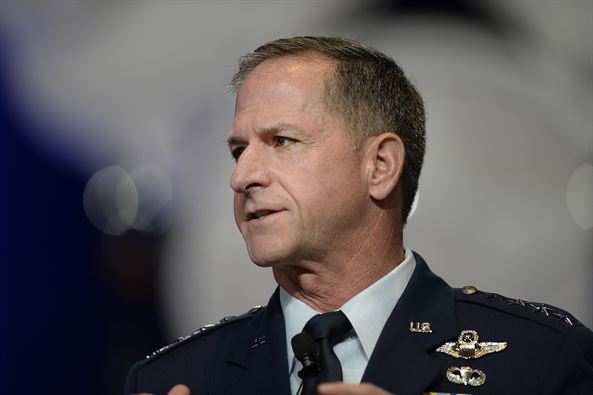
Gen. David Goldfein speaks at AFA's Air, Space, and Cyber Conference at National Harbor, Md., in September 2016. Air Force photo/Scott M. Ash
John A. Tirpak
The Air Force will in September release a long-awaited new Bomber Roadmap which will focus not just on the B-1B, B-2, B-52, and B-21, but enabling technologies and things such as standoff weapons, Chief of Staff Gen. David Goldfein said Wednesday, also promising a new white paper on Air Force priorities.
At a Capitol Hill event sponsored by AFA, Goldfein said Global Strike Command chief Gen. Robin Rand has been in a “very aggressive dialogue with Congress” about USAF’s bomber plans for the last week or so, seeking congressional input and “socializing” the document so there are no surprises when it’s released. “It’s not even just a bomber roadmap,” he said. “It’s a Global Strike roadmap, that includes all these capabilities that come together to allow us to hold these targets at risk” around the world.
Goldfein said it will be increasingly rare to talk about “any particular platform,” since it’s unlikely that any one platform will undertake a solo, unassisted mission from here on out. The new roadmap is likely to discuss the role of the RQ-4 Global Hawk, for example, providing persistent intelligence, surveillance, and reconnaissance that ties in with whatever mission a B-1B may be performing, he said.
Goldfein told Air Force Magazine that the roadmap “is going to be a combination of old and new,” offering the example of a B-52 loaded with standoff weapons, an RQ-4 and “an RQ-170 that gives me penetrating capability…when I add those three together, what does that actually give me?” In upcoming trade studies determining new acquisition priorities, such will be the discussions, of “how do we build those combinations to give us the most agility in the future.”
All missions will be scrutinized for penetrating vs. standoff, manned or unmanned, conventional or unconventional, he said, and then “more broadly” how USAF capabilities can mesh with those of other services. “What can I do if I combine those things with a soldier on the ground, a JTAC (Joint Tactical Air Controller), surface, subsurface, orbital?”
He said the Air Force’s modernization program is still intact, but the readiness priority will have an effect on “what’ll push outside the FYDP,” or Future Years Defense Plan, and whether some things are “pushed right…or pushed left. And it’s all about, how do I get the most return on investment in the connective tissue.”
A new white paper, Goldfein said, which will carry his signature and that of service Secretary Heather Wilson, lays out “five priorities that will drive” the Air Force “over the remainder of our tenure together.” The “Wilson-Goldfein era” has begun, he joked. Those priorities are to “restore our readiness,” pursue “cost-effective modernization,” innovate for the future, “strengthen how we develop airmen and future leaders, and “strengthen alliances” with partner air forces, Goldfein said.
As the top priority, restoring readiness will put “a laser focus on revitalizing squadrons,” as Goldfein has promised to do during his nearly one year in the job. “Our endstrength is finally on the rise,” he said, and the gains in manpower, focused on “first sergeants and commander support staffs” should help.
Modernization, Goldfein said, must finally leave behind “the industrial-age model of acquisition” and move into the “information age model.” More important than a system’s intrinsic capability will be “how does it connect” to the overall family of systems.
The Air Force is already building new career path models that will emphasize and provide incentives for airmen serving in joint billets and air operations centers, “where the operational art” of airpower “is practiced daily.” Those tours will become “more competitive for promotion.” Moreover, “we’re rebuilding Joint Task Force capacity, beginning with 9th Air Force at Shaw AFB, SC…to assure we have certified JTF offerings to combatant commanders to respond to crises and conflict in the future.”
Finally, alliances are something “we have” and adversaries don’t, Goldfein said, calling these relationships the US’ “greatest strategic and asymmetric advantage.”
Goldfein, asked by a reporter whether the Air Force has a number in mind for how many fighters it should have, said it would be “inappropriate” to state one. While almost two years of work on a new National Military Strategy have nearly closed with a new product, Defense Secretary James Mattis’ Defense Strategic review will scrub it yet again. The NMS has “annexes appropriate to all the military challenges” Joint Chiefs chairman Gen. Joe Dunford and Mattis have “laid out, in terms of what we call the four-plus-one framework.”
A net assessment exists of “not only where we are, but where our adversaries are,” and the Mattis-driven review will set “what that force needs to look like to most effectively operate.” The Air Force is “invested” in that review, Goldfein said, and “it’s a perfectly-timed exercise to ensure that we come out…knowing exactly what we need to be able to fight and win in the future.”

